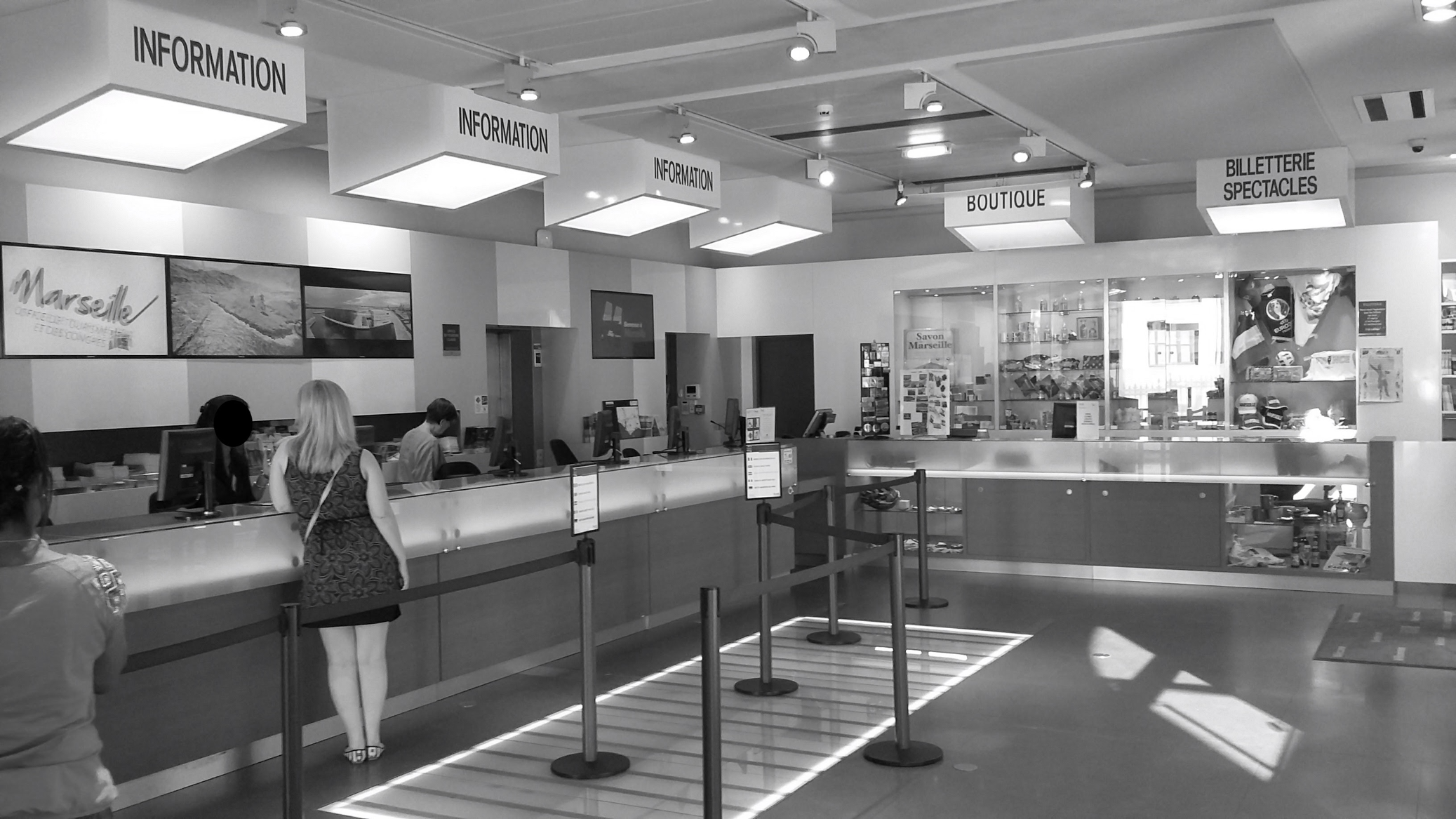This entry explores how ethnographic triangulation became a crucial tool in my fieldwork, allowing me to add layers of complexity to my sociolinguistic descriptions by collecting, comparing and confronting data from different sources.

Discovering Disappointment
On a warm June day in 2014, I vividly remember sitting in the Tourist Office of Marseille towards the beginning of my doctoral fieldwork wondering how on earth the phenomena I was observing could one day be the basis of an interesting PhD. Like any researcher, I felt like I had faced chaos when entering the field for the first time. In order to make sense of it, I had started by focusing on the exchanges taking place between the tourists and the tourist advisers. If I am honest with myself now, I thought that extensive observation and recording of these interactions would provide me with the information I needed to understand the sociolinguistic dynamics of the tourist office, thus responding to the main aim of my PhD.
Given the huge diversity of tourists that pass through the Tourist Office, I had expected – perhaps hoped – to witness all sorts of multilingual practices that would allow me to tie my research into the then-emerging body of work on superdiversity, translanguaging, linguistic resource bricolage and other “globalised” language phenomena. However, as I started to rack up the hours of observation, I began to see very different practices. Far from extensive translanguaging, each exchange I observed took place not only almost exclusively in one sole language but nearly always in one of two specific languages: French or English. I was convinced that the discovery of such a predictable pattern of language use was the death of my PhD.
Despite – or rather because of – my despair, I ploughed on. I began thinking that my exclusive reliance on interactional data might be a hindrance rather than a help. I decided to diversify my fieldwork protocol to include other methods of data collection. Given that the tourist advisers were one half of the interactions I had been recording and observing up to that point, I decided to begin by conducting interviews with these advisers, before moving on to other members of staff in the Tourist Office. I very quickly started to notice a trend emerging which seemed at odds to that which I had observed myself. The almost systematic use of French and English noted during my observations was not reported during interviews with the tourist advisers. Instead, these advisers suggested that the linguistic aspects of their work were mainly characterised by repeated switching between numerous languages. I began to wonder whether such a situation might suggest that the predictable patterns of language use I had observed were in fact more complex than they had initially seemed. Suddenly, my PhD appeared to be not quite as dead in the water as I had feared.
Reaching a Methodological Cul-de-sac
Further detailed analysis of the interactions helped me formulate an explanation as to why systematic use of French and English was barely ever mentioned by advisers despite being highly present in the interactional data I had. This analysis suggested that French and English had become extremely normalised in this context, to the extent that their use was taken for granted, hence their absence in the reports of advisers. The role of interaction in this discovery, as well as the central importance of interaction and its analysis to work in critical ethnographic sociolinguistics, are discussed in another Chronique.
Alongside this information, data from interviews had shown me that more unpredictable multilingual practices played a key role in the way in which advisers conceived of their lived reality of work, even if such practices seemed to be relatively rare according to the interactional data. I began to reflect upon why this might be the case. Why did the advisers seem to bestow so much importance upon practices which did not seem to be among the most common?
Interviewing advisers alone did not really further my understanding of this question. I was able to confirm that advisers did indeed consider unpredictable, multilingual practices to be a defining characteristic of their work, but it was difficult to establish exactly why this might be the case. I felt like I had reached an impasse.
Opening the Data Floodgates
With hindsight, I recognise that the opening period of my fieldwork described above was a bit of a mess. It was my first major fieldwork project and I had severely underestimated the task. As I said, I had thought that my interactional, and then interview, data would be sufficient to answer the research questions I was asking. I quickly came to realise that I was wrong and that, in order to navigate my way out of this methodological cul-de-sac, it would probably be wise to multiply the sources of information I had. It was time to open the floodgates or, as Blommaert and Jie (2010: 58) suggest in their guide to ethnographic fieldwork, to go about “collecting rubbish”. So, without knowing what I would find (or not find), I diversified my methods of data collection even further: I collected together the different documents that were present both front-of-house (maps, tourist guides, etc.) and back-of-house (staff directives, internal policy documents, etc.) in the Tourist Office, I interviewed other social actors in the Tourist Office and undertook documentary research (collecting press articles and documents from third parties pertaining to the Tourist Office and tourism in Marseille in general). This latter process particularly involved contacting and collecting documents published and used by third-party groups such as trade boards, tourism development agencies and tour operators.
Very quickly, it became apparent that all of these data sources were both highly valuable and extremely complimentary. Each source offered a unique perspective on the functioning of the Tourist Office as an institutional context and could therefore offer insight into its sociolinguistic dynamics. Each individual source was valuable in this regard. However, I really felt that I had struck gold when I began to triangulate the different sources and analyses by combining, comparing and confronting the different findings.
By way of example, through interviews with members of the Tourist Office management, I discovered that foreign language skills were considered as one of the key attributes when hiring advisers. Thus, competence in a variety of foreign languages was often a discriminatory factor in gaining and maintaining employment at the Tourist Office. This explained then why advisers might conceive of speaking numerous languages as a key aspect of their work; it was a key aspect of their work in terms of getting a job, regardless of whether this was what they did on a day-to-day basis once in that job.
What’s more, exploring this wealth of data sources opened up new avenues of questioning. Internal documents showed that there was a clear push aimed at developing the Tourist Office’s capacity to accommodate tourists in certain key languages. Why these particular languages? Further sources, this time the secondary document sources mentioned above (and especially those linked to tourism development agencies), provided the answer: the chosen languages corresponded to lucrative demographics being targeted by the tourist office and Marseille’s wider tourism industry.
Clearly, all of these different data sources were valuable contributions to understanding the sociolinguistic dynamics of the Tourist Office as a whole. Each data source provided a different, unique perspective, sometimes confirming or calling into question findings from other data sources, sometimes contributing elements that other data sources could not. Any social situation is a potentially infinite mix of these perspectives and, by multiplying and combining the perspectives explored, the researcher can paint a more detailed picture and complexified understanding of that which is being studied.
For me, this is the methodological manifestation of ethnography’s status as a “holist” enterprise. Sociolinguistic ethnography’s theoretical cornerstone lies in its conception of language and context as an indissociable whole. As Blommaert and Jie (2010: 7) put it: “Language is context, it is the architecture of social behaviour itself, and thus part of social structure and social relations”. Language and context thus cannot be separated, and sociolinguistic ethnographers need a methodological approach that respects this theoretical basis. This requires, as Hymes (1974: 31) himself pointed out, “a mode of description that is jointly ethnographic and linguistic”, allowing us to adequately apprehend all of the different perspectives at play in a situation.
This is what I was able to undertake then at the Tourist Office. Data triangulation – achieved by combining linguistic data (interaction analysis) and various ethnographic elements (interviews, document collection, observation, etc.) – helped me to take into account the multiple aspects of that particular social context and explore how they interlock with each other, thus getting somewhere towards what anthropologist Clifford Geertz (1973) refers to as “thick description”. Of course, we can never successfully analyse every single perspective that makes up a social context. However, as my experience taught me, the more we can multiply these elements in our research, the more this allows the different perspectives to be combined, and the more chance we stand of piecing together a complex and nuanced understanding of the whole.
